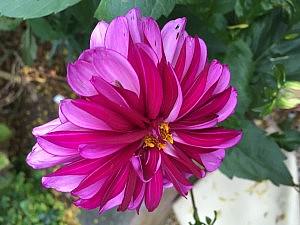Ok, so there are some properly unpredictable April showers happening at the moment but don’t give up on the garden this weekend just yet. There are also some wonderful periods of sunshine and if you get 1 0r 2 things done, you’ll be justified in feeling that you’ve got ahead.
Here are 7 things that will make a difference to your enjoyment of the garden (when you’re not looking for easter eggs) and will not take up all your time.
-
Take stock
Easter weekend is usually the first time that most of us have the time to get out into the garden to take stock of what’s survived the winter and what has not. Look over the herbaceous border and locate the gaps. It’s usually easy to see where they are as most plants are showing some signs of life by now but if not, take a trowel and do a little gentle investigation. If the plant appears lifeless or weak, take it out and indulge yourself (briefly) in the delight of having a bit of space in which to put something new.
Here are some quick steps that will make sure that the replacement plant fits seamlessly into the border.
- Decide on whether you want a plant that flowers in the Spring, Early Summer, Late Summer or Autumn. Suttons have a very useful chart showing the flowering times of various popular perennials if you click on the link.
- Decide on how tall it needs to be (approximately) which will be dictated by where the gap in the border has arisen.
- Decide what colour flower the plant needs to have to fit in with those near it who flower at the same time of year.
- Refresh your memory as to what the conditions are: sun/shade, well drained soil/heavy soil, pH, exposed/sheltered.
- If you don’t know what plant you want, you can find plenty of ideas on the internet, with several sites such as the Royal Horticultural Society and Shoot Gardening who offer a filter tool into which you put the information you’ve identified from the questions above which will then give you plant suggestions based on it.
- Make a list of approx. 3 plants, you like, that could fill the gap and then go shopping!
-
Decide if the design of the garden still works for you?
Think back to last year if there were any ‘niggles’ that you remember about the garden. Were the paths, bins, compost bins, washing line, shed etc in the most convenient place? Has anything changed in a neighbour’s garden that might impact on your enjoyment in the garden? For example my neighbour cut down a couple of overgrown conifers within the boundary hedge, over the winter, which has had the result of completely removing the privacy to our patio. It is now very exposed and it doesn’t feel comfortable to be there so this is something we will have to address in order to enjoy using our patio again. Get these things sorted now.
-
Did you spend too much time looking after the garden last year?
Again, think back to last year to see how you felt about the amount of time it took you to look after the garden. Did you feel it was a burden or did it fit easily into the time you had available? The aim with the garden is to enjoy being in it but this is not going to happen if the design requires more time to look after it than you have available. For a few ideas as to how you can balance the time it takes to look after the garden with the time you have available, click here.
-
Give the lawn a cut.
The grass is beginning to grow so lift the blades to cope with the extra length and give it a light cut, if the weather is dry enough. Cutting the lawn is usually a quick win as it looks good immediately and it smells gorgeous too. Rake out patches of moss and if there are any bald patches, scatter it with a handful of grass seeds.
-
Do a spot of weeding
This is a great take on an old saying “A weed in time, saves nine”. The weeds are beginning to grow and there are even a number of opportunist dandelions in full flower and a few have even gone to seed – already! Do half an hour of weeding whilst the weed plants are still small and you will notice a big difference in the quantity of weeds you have to deal with later on in the year. ‘Little and often’ is a very useful approach to weeding.
-
Plant summer flowering bulbs now.
There are all sorts of summer flowering bulbs, tubers and corms you can get excited about and now is the time to plant them. Go for gladioli, lilies, dahlias, begonias, cannas, crocosmia and calla lilies, Some of these are not hardy, so keep an eye on the weather and if there is a possibility of frost, cover them or if they are in posts, move them to a frost free place eg the greenhouse.
-
Plant up a herb pot to place next to the kitchen door.
Fresh herbs are so easy to grow and if they are close to the kitchen door, are all the easier to use in your cooking. If you don’t have a herb bed nearby, plant up a large pot with staples such as parsley and chives. Once the chance of frost has past, you can plant dill, tarragon and basil out as well or have them in the greenhouse. All of these are perennials so if you want bigger, shrubby herbs such as rosemary, sage and bay you will have to plant them in separate pots or incorporate them into the garden.
A word of caution – keep an eye on the weather forecast because there is still the chance of frost. Cover any plants that are not hardy and any newly emerged seedlings
Get in touch.
We have lots of free garden design ideas and photos on our website www.yorkshiregardendesigner.co.uk and we’d love to hear from you.
Give us a call on 01904 623 343 for a chat about your garden or get in touch via our contact page.


